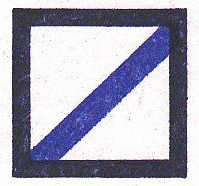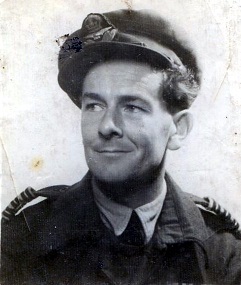
Robert Arnold Sandison was born in Norwood, London on 26th April 1911. Generally known as ‘Sandy’, he came from a long line of Shetlanders who can trace their roots to the 17th Century. He was a cadet at Oxford University Air Squadron from 1931 to 1933 and held a Flying ‘A’ Licence 1932-33. After university he worked as a sales manager for Hugh Wood & Sons of London E1. This was a firm of ship’s chandlers owned by a member of the family.
In April 1940, on his 29th birthday, Sandy married Muriel Nancy, known as ‘Terry’ who was a State Registered Nurse. Terry was to be deeply involved with casualties resulting from the Blitz, especially during the bombing of the London Docks. In December 1940 Sandy joined the RAFVR.
Sandy was granted a commission for the duration of hostilities with effect from 6th December 1940 and became an Acting Pilot Officer on Probation in the Equipment Branch. He attended a three week Discipline Course at Loughborough and then an Equipment Officers Course beginning 27th December 1940. After this training he was posted to the RAF Embarkation Office in Belfast with effect from 22nd February 1941.
He was confirmed in his appointment as Pilot Officer on 6th December 1941 (the first anniversary of commencing service). Promotion to Flying Officer (War Substantive) followed on the 22nd February 1942 (One year after being graded as Pilot Officer on Probation). All this was according to the normal progression for wartime RAFVR officers. However, aptitude and/or opportunity could accelerate the promotion of an officer to an Acting rank considerably higher than the individual’s War Substantive rank. This was the case with Sandy who was obviously a very capable fellow.
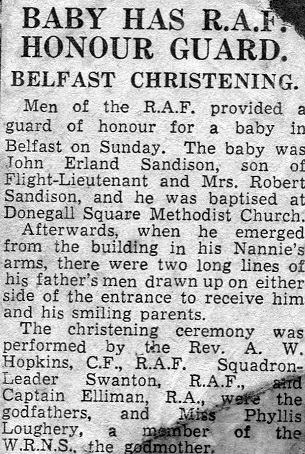
On 15th March 1941, less than a month after joining the Embarkation Office in Belfast, Robert Sandison was appointed Acting Flying Officer (Paid) and he was promoted to Acting Flight Lieutenant (Paid) three months after that, on 15th June 1941. (This while his War Substantive rank was still Pilot Officer on Probation.)
Whilst Sandy was stationed in Belfast, Terry, then heavily pregnant, came to visit her husband. She went into early labour and their son, John Erland Sandison was born, on 28th September 1941.
Sandy retained the rank of Acting Flight Lieutenant when, after 20 months at the Belfast Embarkation Office, he was given a new posting. From 9th November 1942 Sandy was with the Directorate of Movements, Department of AMSORM for ‘Duty in Movements 3’. [Movements 3 was presumably a section of the Directorate of Movements at the Air Ministry.] Sandy remained at the Directorate of Movements for nearly three months.
On 1st February 1943 Sandy was posted to No. 21 Embarkation Unit at Hull. (Embarkation Offices were by now, re-designated as numbered Embarkation Units.) Again, Sandy retained the rank of Acting Flight Lieutenant. He had been at Hull for four months when his RAF career took a new turn.
Sandy was posted to the newly formed No. 76 Beach Unit with effect from 7th June 1943. It is not clear whether or not he was the Commanding Officer of the unit (the unit was formed on 26th May 1943) but this is likely. On 1st July 1943 Sandy’s Non-Substantive rank changed from Acting Flight Lieutenant to Flight Lieutenant (Temporary).
Less than three months after its formation, due to a re-organisation of RAF beach units, No. 76 Beach Unit was disbanded and reformed as No. 103 Beach Section of No. 2 Beach Unit. This occurred with effect from 15th August 1943. On 15th September 1943, Sandy was promoted to Acting Squadron Leader and appointed Officer Commanding No. 103 Beach Section. He led No. 103 Beach Section (later renamed No. 103 Beach Flight) through the winter of 1943/44, training alongside the Army’s No. 7 Beach Group.
On 6th March 1944, Squadron Leader Sandison acted as Army Beach Group Senior Umpire for Exercise “PRANK” which lasted until 11th March. He visited H.M.S. VECTIS at Cowes, Isle of Wight on 16th March. There, ‘He made bids and obtained phasing for No. 103 Beach Section personnel and M.T. vehicles for OPERATION “OVERLORD”‘
Acting Squadron Leader Sandison landed with his Beach Flight in Normandy on D-Day, 6th June 1944, operating in the MIKE Sector of the JUNO assault area (near the village of Graye sur Mer). One of his main concerns at first was the safe assembly of the advance echelons of the R.A.F.’s 2nd Tactical Air Force that immediately began to come ashore in his Sector of the beachhead. The planned R.A.F. Assembly Area was untenable and units were unable to move forwards. Alternative plans were made and the situation was brought under control.
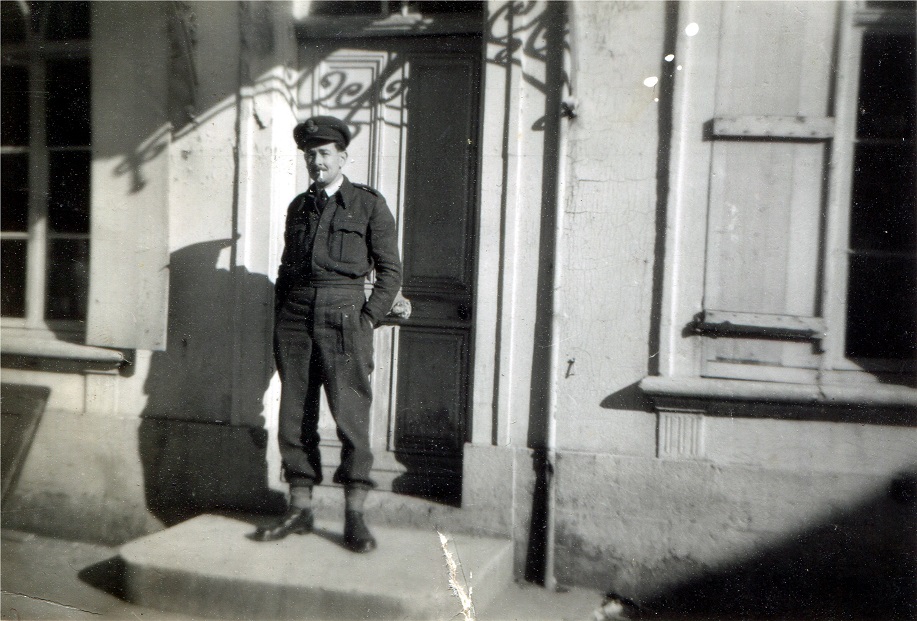
After six weeks of hard work in the beachhead, No. 103 Beach Flight was disbanded as a Flight on the 17th July 1944. Sandy was put in charge of No. 2 Beach Squadron’s Operations Room, dealing with all matters appertaining to Shipping, Operational Returns, Loadings, Landings, Returns of Personnel, M.T. and Stores, and return of Personnel to the U.K. The Sections that were previously administered by 103 Beach Flight H.Q. now came under the direct control of Squadron Headquarters.
With the work of the Beach Squadrons coming to an end and the units being disbanded, Sandy was posted to 89 Embarkation Unit on 15th August 1944. No. 89 Embarkation Unit was operating at the Mulberry harbour at Arromanches and was the unit to which the Beach Squadrons mostly handed over their responsibilities. He was promoted to Flight Lieutenant (War Substantive) on 15th September and continued to hold his Non-Substantive rank of Acting Squadron Leader.
On 4th October 1944 Sandy began a series of continuous attachments to No. 85 Embarkation Unit, again retaining the rank of Acting Squadron Leader. No. 85 Embarkation Unit had detachments in Normandy at Caen from 17th August 1944 and at Ouistreham from 28th August 1944. It seems that his attachment to 85 Embarkation Unit finally ceased on 6th December 1944. Meanwhile, 89 Embarkation Unit had moved to Calais on 25th November 1944, so Sandy then moved on to Calais.
Sandy carried a German cap button on his key ring for years. When his son asked him where it came from he said that he took it from a German prisoner at a doodle-bug launching site somewhere near Calais. Apparently the allies were able to capture it before it was fully commissioned. Other than that he would not elaborate.
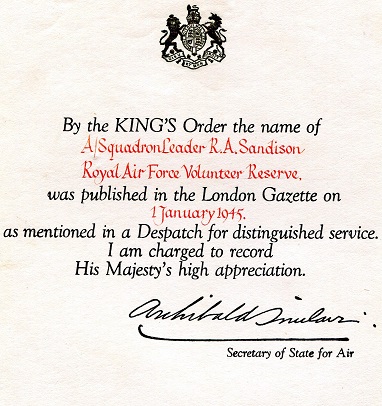
Acting Squadron Leader Sandison was ‘Mentioned in Despatches’ for his work in Normandy with No. 2 Beach Squadron. This was published in Issue 36866 of the London Gazette, dated 29 December 1944.
On 2nd May 1945 Sandy was promoted to Acting Wing Commander and posted to No. 100 Embarkation Unit, probably as Commanding Officer. This new unit was formed at West Kirby on 8th May 1945 and was in Hong Kong from 4th September 1945. However, Sandy was part of the Advance Survey Party for Tiger Force, also known as the Very Long Range Bomber Force, that was to be deployed in the Pacific theatre, and he left the U.K. for South East Asia at the end of July 1945.
Departing from Northolt on 30th July he flew to Malta and then on to Cairo, arriving at Cairo West on 31st July. Leaving Cairo on 2nd August he went via Karachi to Calcutta. He left Calcutta on 6th August and flew ‘over the hump’ to China, arriving at Luliang that same day. Luliang Air Base in Yunnan Province was used by the United States Army Air Force’s Fourteenth Air Force. Sandy was there for three days. He then flew to Okinawa via Manila, arriving in Okinawa on 11th August.
Okinawa was the planned base for Tiger Force, which was to have used Lancaster, Lincoln and Liberator aircraft, flown by British and Commonwealth crews, for the bombing of Japan. The war with Japan ended soon after Sandy arrived in Okinawa which removed the requirement for the Very Long Range Bomber Force (by which title Tiger Force was also known).
Meanwhile, Shield Force, which was a convoy of eight cargo ships containing 15,000 tons of airfield constructional stores and equipment and 1,000 vehicles plus a personnel ship carrying 3,100 RAF airfield construction personnel and administrative details, had sailed from the U.K., passed through the Panama Canal and crossed the Pacific Ocean. The intention had been to set up an airfield in Okinawa but while Shield Force paused at Manus in the Admiralty Islands, a reconsideration of plans was made. They were ordered to proceed to Hong Kong, take over the peninsular and establish law and order. Sailing north past the Philippines on 29th August, a typhoon forced the Shield Force personnel ship “Empress of Australia” and her escorts, to divert to the Philippines island of Leyte.
Following the change of plans, Sandy flew from Okinawa to Leyte on 25th August and was there until 2nd September when he boarded H.M.S. Vengeance, a Colossus-class Light Fleet Aircraft Carrier and sailed to Hong Kong, disembarking on 5th September 1945 when the first Shield Force RAF personnel went ashore from “Empress of Australia”. The British proceeded to regain control of Hong Kong and Rear Admiral Sir Cecil Halliday Jepson Harcourt formally accepted the Japanese surrender of Hong Kong on 16th September at Government House.
Somewhat confusingly, Sandy’s record shows he was posted to No. 1 Embarkation Unit on 4th September 1945. No. 1 Embarkation Unit was in London, at this time located at Portsoken House, 157 Minories, London EC3. This posting is, however, shown as being under the authority of Air Command South East Asia (ACSEA).This is hard to explain unless it was an error or an administrative device to cover his special position.
On 5th November 1945 Sandy was posted to No. 68 Embarkation Unit. He is shown as being Commanding Officer of this unit, which was in Singapore. Still with ACSEA, Sandy’s next posting, on 10th December 1945, was to a unit that appears on his record to be ‘100 G Unit’. He was the Commanding Officer of the unit, still with the rank of Acting Wing Commander and remained with it for a year.
On 12th January 1946 Sandy was posted to Air Headquarters Burma. He was promoted Squadron Leader (War Substantive) with effect from 2nd May 1946 and still retained the rank of Acting Wing Commander.
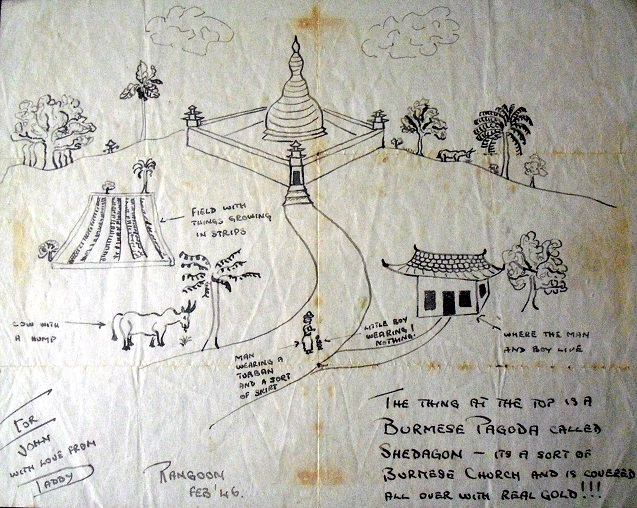
Sandy was offered an Extended Service Commission but did not accept. On 19th May 1946 he was posted to 104 Personnel Despatch Centre at Hednesford in Staffordshire as Supernumery for Class A Release. He finally relinquished his commission on 26th April 1956 retaining the rank of Wing Commander.
After the war Sandy was, for a time, honorary treasurer of the R.A.F.A. He was also finance director for the World Veterans Federation, headquartered in Paris, for a number of years. The World Veterans Federation had a worldwide membership of ex-soldiers and had ‘Category A’ status with the United Nations especially in the field of the rehabilitation of the disabled. Throughout his life Sandy considered that too little was done for those that were disabled. He took great pride in having been involved with the first ‘international’ Paraplegic Games held at Stoke Mandeville in 1955. There had been early games but this was considered the first multinational event. Roger Bannister and the French heroine of Dien Bien Phu, Geneviève de Galard were guests of honour.
Sandy rarely spoke of the war or any part that he played in it. The photograph below was taken on the 6th June when Sandy and his wife Terry were on holiday in Normandy, some time in the 1970s. Terry said that only reluctantly did Sandy agree to show her where he had landed.
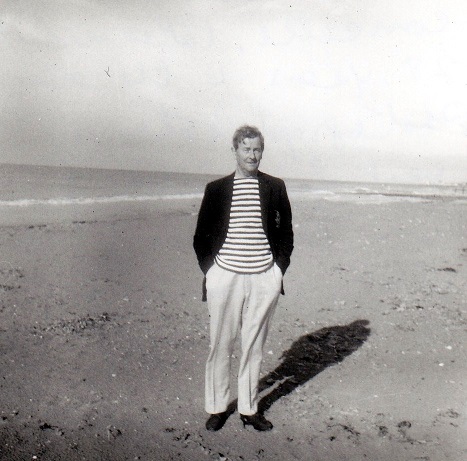
Many thanks to John Sandison (also known as Sandy) who made this page possible by sharing information about his father and the photographs.
